I have a set of convex polygons with a moderate number of sides (say from 4 to 30). There are a few tenths of polygons, say 100 to 1000. Most of them are isolated but a few form small groups of 2 to 10 that overlap between them.
I need to efficiently identify those groups of overlapping polygons.
Is there a classical algorithm ? (I am thinking of a sweepline approach but maybe there's better ?) Would it be beneficial to enclose the polygons in boxes before the detection ?
Below, a representative case.
